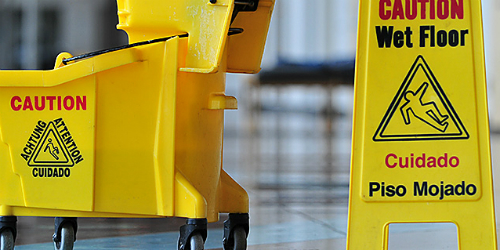Slips, Trips, and Falls

Falls are one of the most common causes of workplace injuries. Falls can be from a level surface or from a height, or elevated surface. On a level surface, falls are usually the result of a slip or a trip. Falls from a height can be from a ladder, a roof or an aerial lift. Falls on stairways usually result from a slip or a trip, even though it’s not a level surface.
Many falls on a level surface occur because of a hazard. Slips are the result of losing traction on a surface such as a spill or slippery substance on a floor. A trip results from an obstacle on a floor or an uneven surface. An electrical cord across an aisle way, or an uneven pavement are examples of trip hazards. Few falls are intentional; most can be prevented by taking precautions. The most preventable type of fall is one where a spill wasn’t cleaned up or a warning barricade was not placed allowing someone to not be aware of the hazard.
The term “slips, trips, and falls” usually refers to falls on a level surface or from a relatively low height such as a ladder. Falls from a height where special personal protective equipment is required are covered under Fall Protection standards. Cal-OSHA regulates the control of fall hazards through general industry and construction industry safety orders. Fall protection requirements will be found within the regulation for the type of equipment or the access regulated.
The use of a ladder, scaffold, or an aerial lift requires training and special precautions. In some cases, barriers are used to prevent falling such as toe-guards or railings on construction projects or staircases. Anyone using a ladder or aerial lift must be trained to use it correctly. Work on a roof, in a bucket or mobile scaffold may require the worker to use a fall protection harness. This requires additional special training.
To get more information on the applicability of Slip, Trip, and fall protection for a specific County operation please contact the corresponding departmental Safety Coordinator.
For further information on specific regulatory guidelines please refer to the link(s) below:
Cal-OSHA Working Area (General Industry)
Cal-OSHAPortable Ladders (General Industry)
Cal-OSHAFall Protection in Construction Fact Sheet
OSHAWalking-Working Surfaces (General Industry 1910.21 – 1910.30)
 Translate
Translate